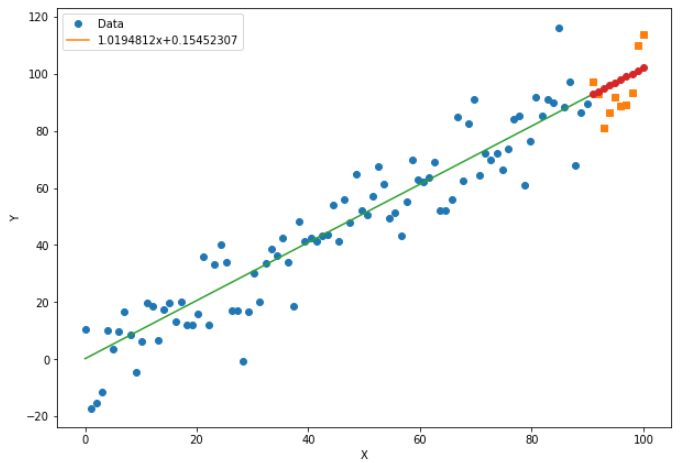1.准备数据
import torch from torch.autograd import Variable # 构造0-100之间的均匀数字作为时间变量x x = Variable(torch.linspace(0,100).type(torch.FloatTensor)) # 时间点上的历史房价数据 rand = Variable(torch.randn(100)) * 10 # 均值为0,方差为10。 torch.randn(100)生成100个标准正态分布随机数 y = x + rand x_train = x[: -10] #倒数第10个元素之前的所有元素 x_test = x[-10:] #最后面10个元素 y_train = y[: -10] y_test = y[-10:] # 训练数据点可视化 import matplotlib.pyplot as plt %matplotlib inline plt.figure(figsize=(10,8)) #设定绘制窗口大小为10*8inch #绘制数据,由于x和y都是Variable,需要用data获取它们包裹的Tensor,并转成Numpy plt.plot(x_train.data.numpy(), y_train.data.numpy(),'o') plt.xlabel('X') plt.ylabel('Y') plt.show()

Varibale包含三个属性:
data:存储了Tensor,是本体的数据
grad:保存了data的梯度,本事是个Variable而非Tensor,与data形状一致
grad_fn:指向Function对象,用于反向传播的梯度计算之用。就是计算图中的箭头
2.模型设计及训练
# y = ax+b #定义两个自动微分变量a和b a = Variable(torch.rand(1),requires_grad = True) b = Variable(torch.rand(1),requires_grad = True) learning_rate = 0.0001 for i in range(1000): predictions = a.expand_as(x_train) * x_train + b.expand_as(x_train) #使用expand_as提升a和b的尺寸,a.expand_as(x_train)是将a的维度调整为何x_train一致 loss = torch.mean((predictions - y_train) ** 2) print('loss:',loss) loss.backward() #对损失函数进行梯度反传 a.data.add_(- learning_rate * a.grad.data) #在PyTorch中,如果某个函数后加了'_',表明要用这个函数的计算结果更新当前的变量;例如a.data.add_(3)是将a.data的数值更新为a.data加上3 b.data.add_(- learning_rate * b.grad.data) a.grad.data.zero_() #清空存储在变量a和b中的梯度信息,以免在backward的过程中反复不停地累加 b.grad.data.zero_() # 画出原始散点图和拟合后的直线 x_data = x_train.data.numpy() plt.figure(figsize = (10,7)) xplot, = plt.plot(x_data, y_train.data.numpy(),'o') yplot, = plt.plot(x_data,a.data.numpy()*x_data + b.data.numpy()) #绘制拟合直线图 plt.xlabel('X') plt.ylabel('Y') str1 = str(a.data.numpy()[0])+'x+'+str(b.data.numpy()[0]) plt.legend([xplot, yplot],['Data',str1]) plt.show()

3.预测
predictions = a.expand_as(x_test)*x_test + b.expand_as(x_test)
predictions

import numpy as np x_data = x_train.data.numpy() x_pred = x_test.data.numpy() plt.figure(figsize = (10,7)) plt.plot(x_data, y_train.data.numpy(),'o') #训练数据 plt.plot(x_pred, y_test.data.numpy(),'s') #测试数据 x_data = np.r_[x_data, x_test.data.numpy()] plt.plot(x_data,a.data.numpy()*x_data + b.data.numpy()) #绘制拟合数据 plt.plot(x_pred,a.data.numpy()*x_pred + b.data.numpy(),'o') #绘制预测数据 plt.xlabel('X') plt.ylabel('Y') str1 = str(a.data.numpy()[0])+'x+'+str(b.data.numpy()[0]) plt.legend([xplot, yplot],['Data',str1]) plt.show()
